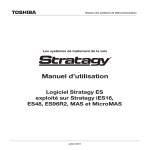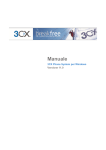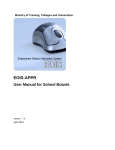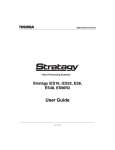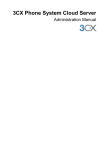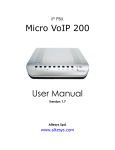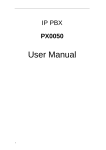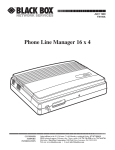Download 3CX Phone System for Windows Manual
Transcript
Manual 3CX Phone System for Windows Version 7.0 Copyright 2006-2008, 3CX ltd. http://www.3cx.com E-mail: [email protected] Information in this document is subject to change without notice. Companies’ names and data used in examples herein are fictitious unless otherwise noted. No part of this document may be reproduced or transmitted in any form or by any means, electronic or mechanical, for any purpose, without the express written permission of 3CX Ltd. 3CX Phone System for Windows is copyright of 3CX Ltd. 3CX is a registered trademark, and 3CX Phone System for Windows and the 3CX logo are trademarks of 3CX Ltd. in Europe, the United States and other countries. Version 7.0 – Last updated 27 November 2008 Table of Contents 1. Introduction to 3CX Phone System for Windows...................................................................... 9 What is 3CX Phone System for Windows?.............................................................................. 9 Benefits of an IP Phone System / IP PBX................................................................................ 9 How an IP Phone system works............................................................................................. 11 SIP phones ............................................................................................................................. 11 Software based SIP phones .............................................................................................. 12 Hardware based SIP Phones ............................................................................................ 12 Analogue phones / Fax machines using an ATA adapter................................................. 12 3CX Phone System editions................................................................................................... 12 What’s new in 3Cx Phone System V7?.................................................................................. 13 All versions......................................................................................................................... 13 Small Business, Pro and Enterprise editions .................................................................... 13 2. Installing 3CX Phone System for Windows............................................................................. 15 System requirements.............................................................................................................. 15 Windows Vista users:......................................................................................................... 15 Windows 2008 users:......................................................................................................... 16 Run set-up .............................................................................................................................. 16 Run the 3CX Phone System configuration wizard................................................................. 16 Upgrading from a previous version of 3CX Phone System ................................................... 18 Activating 3CX Phone System ............................................................................................... 18 Firewall configuration.............................................................................................................. 19 3CX Phone System behind a NAT / firewall...................................................................... 19 Firewall installed on the 3CX Phone System machine ..................................................... 20 The 3CX Extension user manual............................................................................................ 20 Installing the 3CX VOIP Phone .............................................................................................. 20 The 3CX VOIP Client User manual........................................................................................ 21 3. Creating Extensions................................................................................................................. 23 Introduction ............................................................................................................................. 23 Adding Extensions .................................................................................................................. 23 User and Authentication information ................................................................................. 24 Voice mail options.............................................................................................................. 24 Configuring the SIP phones.................................................................................................... 25 Phone provisioning ................................................................................................................. 25 Testing your setup .................................................................................................................. 26 1. Check Phone System status with the status monitor.................................................... 26 2. Place a call to another extension................................................................................... 27 3. Troubleshooting tips....................................................................................................... 27 Forwarding rules - extension behaviour on busy, no answer etc. ......................................... 27 Importing extensions............................................................................................................... 29 4. Adding PSTN line(s) via a VOIP Gateway .............................................................................. 31 Introduction ............................................................................................................................. 31 What is a VoIP Gateway or VoIP add in card? ................................................................. 31 PSTN line configuration overview...................................................................................... 31 Definitions........................................................................................................................... 32 Step 1: Create the PSTN gateways in 3CX Phone System .................................................. 32 Step 2: Configure the VoIP gateway ...................................................................................... 35 Generating a configuration file........................................................................................... 35 Configuring the PSTN Interface......................................................................................... 35 5. Adding lines hosted by a VOIP Provider................................................................................. 37 Introduction ............................................................................................................................. 37 Requirements for using a VOIP provider ............................................................................... 37 Step 1: Create an account with a VOIP Provider................................................................... 37 Step 2: Add the VoIP provider account in 3CX Phone System ............................................. 37 6. Creating Outbound Call Rules................................................................................................. 41 Introduction ............................................................................................................................. 41 Creating an outbound call rule ............................................................................................... 41 7. The Digital Receptionist / Auto attendant................................................................................ 43 Introduction ............................................................................................................................. 43 Recording a menu prompt ...................................................................................................... 43 Recording the prompt in Windows Sound Recorder......................................................... 43 Creating a digital receptionist ................................................................................................. 44 Allowing callers to dial a known extension directly ................................................................ 45 Call By Name.......................................................................................................................... 46 Self-identification Message................................................................................................ 46 Calling ................................................................................................................................ 46 8. Adding Direct numbers using DID/DDI lines ........................................................................... 49 Introduction ............................................................................................................................. 49 DID numbers and 3CX Phone System – How it works.......................................................... 49 Adding DID’s ........................................................................................................................... 49 Troubleshooting DID lines ...................................................................................................... 51 9. Ring groups, Call Queues, Paging / Intercom......................................................................... 53 Ring Groups............................................................................................................................ 53 Paging / Intercom (Paid editions only) ................................................................................... 54 Call Queues (Paid editions only) ............................................................................................ 55 10. Call conferencing................................................................................................................... 57 Introduction ............................................................................................................................. 57 Enabling conferencing ............................................................................................................ 57 Creating a call conference...................................................................................................... 57 11. Generating Call Reports........................................................................................................ 59 Introduction to reports............................................................................................................. 59 Installing 3CX Call Reporter ................................................................................................... 59 Importing the call logs............................................................................................................. 59 Running 3CX Call Reporter.................................................................................................... 60 12. Connecting 3CX Phone Systems.......................................................................................... 61 Introduction ............................................................................................................................. 61 Creating a bridge .................................................................................................................... 61 Calling a party on the other 3CX Phone System ................................................................... 64 13. Backup and Restore .............................................................................................................. 65 Introduction ............................................................................................................................. 65 Running backup & restore from the command line:.......................................................... 65 Scheduling backup & restore............................................................................................. 65 Backing up call logs ................................................................................................................ 66 14. Fax server.............................................................................................................................. 67 Introduction ............................................................................................................................. 67 Sending faxes overview..................................................................................................... 67 Receiving faxes overview .................................................................................................. 67 Fax receiving configuration..................................................................................................... 67 Fax sending configuration ...................................................................................................... 68 Step 1: Install Microsoft Fax Server................................................................................... 68 Step 2: Install the 3CX Microsoft Fax driver...................................................................... 69 Step 3: Configuring Microsoft Fax to use the 3CX Fax server driver ............................... 69 Step 4: Install the Fax clients............................................................................................. 71 Changing the Fax Server Credentials .................................................................................... 71 15. Monitoring your Phone System ............................................................................................. 73 Introduction ............................................................................................................................. 73 Things to monitor .................................................................................................................... 73 3CX services ...................................................................................................................... 73 Events posted .................................................................................................................... 73 Performance monitors........................................................................................................ 73 Monitor IP’s of gateways and phone system..................................................................... 74 16. Troubleshooting..................................................................................................................... 75 Introduction ............................................................................................................................. 75 Manual .................................................................................................................................... 75 Configuration guides............................................................................................................... 75 Support FAQ ........................................................................................................................... 75 Request support via our support system................................................................................ 75 Index ............................................................................................................................................ 77 3CX Phone System for Windows System for Windows www.3cx.com 1. Introduction to 3CX Phone System for Windows What is 3CX Phone System for Windows? 3CX Phone System is a software-based IP PBX that replaces a traditional PBX and delivers employees the ability to make, receive and transfer calls. The IP PBX supports all traditional PBX features. An IP PBX is also referred to as a VOIP Phone System, IP PABX or SIP server. Calls are sent as data packets over the computer data network instead of via the traditional phone network. Phones share the network with computers and separate phone wiring can therefore be eliminated. With the use of a VOIP gateway, you can connect existing phone lines to the IP PBX and make and receive phone calls via a regular PSTN line. The 3CX phone system uses standard SIP software or hardware phones, and provides internal call switching, as well as outbound or inbound calling via the standard phone network or via a VOIP service. Benefits of an IP Phone System / IP PBX Much easier to install & configure then a proprietary phone system: A software program running on a computer can take advantage of the advanced processing power of the computer and user interface of Windows. Anyone with an understanding of computers and windows can install and configure the PBX. A proprietary phone system often requires an installer trained on that particular proprietary phone system. Easier to manage because of web based configuration interface: A VOIP phone system has a web based configuration interface, allowing you to easily maintain and fine tune your phone system. Proprietary phone systems often have difficult to use interfaces which are designed so that only the phone system installers can use it effectively. Call cost reduction: You can save substantially by using a VOIP service provider for long distance or international calls. Easily connect phone systems between offices/branches via the Internet or WAN and make free phone calls. No need for separate phone wiring – use computer network: A VOIP phone system allows you to connect hardware phones directly to a s tandard computer network port (which it can share with the adjacent computer). Software phones can be installed directly onto the PC. This means that you do not need to install & maintain a separate wiring network for the phone system, giving you much greater flexibility to add users/extensions. If you are moving into an office and have not yet installed phone wiring, you can save significantly by just installing a computer network. No vendor lock-in: Page 9 3CX Phone System for Windows System for Windows www.3cx.com VOIP phone systems are open standard – all modern IP PBX systems use SIP as a protocol. This means that you can use almost any SIP VOIP phone or VOIP gateway hardware. In contrast, a proprietary phone system often requires proprietary phones, designed specifically for that phone system and proprietary expansion modules to add features and lines. Scalable: Proprietary systems are easy to outgrow: Adding more phone lines or extensions often requires expensive hardware upgrades. In some cases you need an entirely new phone system. Not so with a VOIP phone system: a standard computer can easily handle a large number of phone lines and extensions – just add more phones to your network to expand! Better customer service & productivity: Because calls are computer based, it i s much easier for developers to integrate with business applications. For example: an incoming call can automatically bring up the customer record of the caller, dramatically improving customer service and cutting cost. Outbound calls can be placed directly from Outlook, removing the need for the user to type in the phone number. Software based Phones are easier to use: It i s often difficult to use advanced phone system features such as conferencing on proprietary phones. Not so with software based SIP phones – all features are easily performed from a user friendly windows GUI. More features included as standard: Because a VOIP phone system is software based, it is easier for developers to improve feature sets and performance. Therefore most VOIP phone systems come with a rich feature set, including auto attendant, voice mail, call queuing and more. These options are often very expensive in proprietary systems. Better control via better reporting: VOIP settings store inbound and outbound call information in a database on your server, allowing for much more powerful reporting of call costs and call traffic. Better overview of current system status and calls: Proprietary systems often require expensive ‘system’ phones to get an idea what is going on in your phone system. Even then, status information is cryptic at best. With VOIP systems you can define which users can see phone system status graphically via a web browser. Allow users to hot plug their phone anywhere in the office: Users simply take their phone, plug it into the nearest Ethernet port and they keep their existing number! Allows easy roaming of users: Calls can be diverted anywhere in the world because of the SIP protocol characteristics For more information about the benefits of an IP PBX, visit the IP PBX FAQ at http://www.3cx.com/PBX/IP-PBX-faq.html Page 10 3CX Phone System for Windows System for Windows www.3cx.com How an IP Phone system works A VOIP Phone System, also referred to as an IP PBX, consists of one or more SIP standard based phones, an IP PBX server and optionally a VOIP Gateway. The IP PBX server is similar to a proxy server: SIP clients, being either soft phones or hardware based phones, register with the IP PBX server, and when they wish to make a call they ask the IP PBX to establish the connection. The IP PBX has a directory of all phones/users and their corresponding sip address and thus is able to connect an internal call or route an external call via either a VOIP gateway or a VOIP service provider. Figure 1 - VOIP Phone System Overview The image illustrates how an IP PBX integrates on the network and how it uses the PSTN or Internet to connect calls. For more information about how an IP PBX works, visit the IP PBX FAQ at http://www.3cx.com/PBX/IP-PBX-faq.html SIP phones A VOIP phone system requires the use of SIP phones. These phones are based on the Session Initiation Protocol (SIP), an industry standard to which all modern IP PBXs adhere. The SIP protocol defines how calls should be established and is specified in RFC 3261. Because of SIP, it is possible to mix and match IP PBX software, phones and gateways. This protects your investment in the phone hardware. SIP phones are available in several versions/types: Page 11 3CX Phone System for Windows System for Windows www.3cx.com Software based SIP phones A software based SIP phone is a program which makes use of your computers microphone and speakers, or an attached headset to allow you to make or receive calls. Examples of SIP phones are the included 3CX VOIP Client, SJPhone from SJlabs or XLite from Counterpath. Hardware based SIP Phones Figure 2 - A hardware sip phone A hardware based SIP phone looks like and behaves like a normal phone. It’s actually a mini computer that connects directly to the computer network. Because they have an integrated mini hub, they can share a network connection point with a computer, eliminating the need for an additional network point for the phone. Examples of hardware SIP phones are GrandStream GXP-2000 or SNOM 320. Analogue phones / Fax machines using an ATA adapter Figure 3 - An ATA adapter If you want to use your current phone or analog fax machine with the VOIP phone system, you can use an ATA adapter. An ATA adapter allows you to plug in the Ethernet network jack into the adapter and then plug the phone into the adapter. This way your old ‘regular’ phone will appear to the VOIP phone system software as a SIP phone. 3CX Phone System editions 3CX Phone System is available in 4 different versions – a Free Edition, a MINI edition, a Small Business Edition, a Pro Edition and an Enterprise edition. A detailed feature Page 12 3CX Phone System for Windows System for Windows www.3cx.com comparison between versions is available at this location: http://www.3cx.com/phonesystem/enterprise-features.html Pricing information and ordering http://www.3cx.com/ordering/index.php information can be found here: What’s new in 3CX Phone System V7? All versions · Completely revamped interface, with many usability improvements · Ability to set advanced forwarding rules per extension based on caller ID and time · Apache was replaced by a Microsoft Web Server, Cassini, which is more windows friendly · Added support for running as a virtual instance in Hyper V · New configuration wizard which makes first setup easier · Improved performance of system. Small Business, Pro and Enterprise editions · New, easier to navigate MyPhone interface · Ability to offer callers a way to exit out of the queue and leave a message instead of waiting · Ability to have callers go straight to voice mail if no one is manning the queue. · Support for using Sangoma cards as VoIP Gateways, either installed on the same machine or on a remote machine · Resolve inbound calls to an outlook contact – incoming calls can automatically bring up the appropriate contact record based on the caller ID Page 13 3CX Phone System for Windows System for Windows www.3cx.com 2. Installing 3CX Phone System for Windows System requirements 3CX Phone System for Windows requires the following: · Windows XP Pro, Vista, 2003 server or 2008 · Port 5060 (SIP), 5080 (Tunnel - Optional) to be opened · Port 5480, 5482, 5483, 5485 to be free · One port for IIS, 3 if using Cassini (5000, 5481, 5484) · .NET Framework version 2.0 or higher · 1 Gigabyte Memory or higher, Pentium 4 processor or up · IIS is recommended so that you can use it as the web server Recommended · IIS (Internet Information Services) · 3CX Supported SIP Phones ( http://www.3cx.com/sip-phones/index.html) & VOIP Gateways (http://www.3cx.com/voip-gateways/) · 3CX supported VoIP Providers · If you are using a VOIP provider, you must have a firewall that is configured to do static port mapping. A static IP is highly recommended also! For more information see: http://www.3cx.com/support/nat-firewalls.html · The web based management console is optimized for Internet Explorer v7. It also works with Firefox 2 & 3, however there are some minor display issues. You will need to have a good basic understanding of Windows Networking. It is recommended to read up on IP PBX’s & SIP. For more information visit the IP PBX FAQ at http://www.3cx.com/PBX/IP-PBX-faq.html Windows Vista users: To install 3CX Phone System on Vista, you need to disable UAC (user account control). To disable UAC do the following: 1. Open Administrative Tools in Control Panel and double-click on System Configuration 2. Click Continue to accept the UAC prompt 3. Select the Tools tab, scroll down and select Disable UAC 4. Click Launch and Reboot your machine Page 15 3CX Phone System for Windows System for Windows www.3cx.com Windows 2008 users: You will need to install additional components. Go to 1. Control Panel > Programs and Features 2. Turn Windows Features on or off > Features 3. Now Add features: Desktop Experience, Quality Windows Audio Video Experience (Optional). This will install all the codecs required by 3CX for audio in Windows. 4. For the IE browser to work on the server, you must disable Internet Explorer Security Enhancement. To do this: a. Go to Start -> Programs -> Administrative Tools -> Server Manager b. Ensure that the root node is selected c. In the "Server Summary" section, in the "Security Information" sub-section, Click on the "Configure IE ESC" link. d. Set to "Off" for those types of users that will be administering the PBX. Run set-up 1. Download the latest version of 3CX Phone System from http://www.3cx.com/ippbx/downloadlinks.html. Run set-up by double-clicking on the set-up file. Click ‘Next’ to start installation. 2. You will be asked to review and approve the license agreement, as well as to choose an installation location. 3CX Phone System will need a minimum of approximately 50 MB of free hard disk space. You will need to reserve additional space to store voice mail files & prompts. 3. Select the installation location and click Next 4. You will be asked whether you wish to use IIS or the in-built web server. We recommend using IIS because of performance and stability. The inbuilt web server (Cassini) can be used for evaluation purposes. 5. Click ‘Install” to start the installation of 3CX Phone System. Setup will now copy all files and install the necessary Windows services. After set-up has completed copying files and installing the services, set-up will run the 3CX Phone System Configuration Wizard to complete the install. Click ‘Finish’. Run the 3CX Phone System configuration wizard 1. The 3CX Phone System configuration wizard walks you through a number of essential tasks that you need to do in order to get your system up and running. After it starts up, it will ask in which language you want the wizard to run. 2. The wizard will ask you how many digits you wish your extension numbers to be. 3. Set-up will prompt you for the FQDN of 3CX Phone System. IP phones contact the phone system server using an IP OR an FQDN. If using an FQDN, then you must specify the FQDN of the server. This value is not relevant if you specify the IP of the Page 16 3CX Phone System for Windows System for Windows server in the phone configuration. http://www.3cx.com/support/sip-domain.html www.3cx.com For more information, see 4. It will ask you for your mail server name and reply to address. These settings are used to send email notifications, voice mail and faxes. 5. It will ask you for a preferred username and password to be used to logon to the 3CX Phone System management console and manage the phone system. Screenshot 1 - The 3CX Configuration Wizard 6. Set-up will allow you to create a number of extensions. You can create more later, however you need to create at least one extension. After you have created the extensions, you need to configure your phone sets. 3CX has configuration guides for many popular phones at http://www.3cx.com/sip-phones/index.html 7. In the next step it will ask you to specify the operator extension. The operator extension is the default extension used to route inbound calls to. Specify which extension will act as the operator extension. The operator extension will be the default destination for all inbound lines and DID’s 8. To add VOIP Gateways or VOIP providers follow the instructions provided in the screen. 9. 3CX Phone System Wizard will prompt you whether you would like to receive a quote for a complete phone system. If yes, fill in your details and 3CX or a 3CX partner will send you a detailed quote. You can skip this step if you wish. Page 17 3CX Phone System for Windows System for Windows www.3cx.com After the Wizard has completed, you can connect to the 3CX Phone System Management Console by clicking on the management console short cut in the 3CX Phone System program group. To connect to the management console from a remote machine, start a web browser and enter the name of the machine on which 3CX Phone System is installed, followed by ‘Management’. (For example: http://phone-system/Management) If you are using Cassini, you have to append the port number, 5481. For example http://phone-system/:5481 Upgrading from a previous version of 3CX Phone System It is possible to upgrade a 3CX Phone System 6.1 installation to version 7 as follows: 1. Before uninstalling version 6.1, backup your current configuration using the backup and restore tool located in the 3CX program group. 2. Uninstall version 6 using Add/Remove programs. 3. Install 3CX Phone System v7 and run the configuration wizard. 4. Restore your version 6 configuration using the backup and restore tool located in the 3CX program group. 5. If you are using IIS (recommended), after the upgrade you must go into each extension and click ‘save’. This will recreate the provisioning file, which needs to be updated because the URL changed. Also you will need to URL to the provisioning server in each phone. You can either do this manually for each phone according to the configuration guide, or automatically using ‘option 66’ in your DHCP server. See this URL for a configuration guide http://www.3cx.com/sip-phones/DHCP-option66.html Note: · DIDs & bridges created in version v6 are not restored in v7. These need to be recreated. · Upgrades of version 3.1, 5, 6.0 configurations are not supported. In these cases, make a backup of your old configuration. Install v6.1 on to a separate machine, do a restore it and then a backup. Then restore that 6.1 backup to v7. · Upgrades from any V7 BETA version are not supported. Activating 3CX Phone System If you have purchased a MINI, Small Business, Pro or Enterprise version then you can activate your license by going to the General > Activate License page in the 3CX Management Console. Page 18 3CX Phone System for Windows System for Windows www.3cx.com Screenshot 2 - Activating your license Enter your license key, Company, Contact Name, E-mail, Telephone and Country and click on “Activate” to activate your license. This information will be sent to our license key server and your license key and installation will be activated. You will need to do this each time you re-install 3CX Phone System or install an upgrade. Firewall configuration There are 2 scenarios in which you will need to update your firewall configuration: 1. If your PBX server is behind a NAT / firewall and you intend to use a VOIP provider 2. If you are using a firewall on the PBX server itself, for example Windows Firewall 3CX Phone System behind a NAT / firewall The best place for 3CX Phone System i s on a machine behind the firewall. This configuration is easier and more secure. If you will just use PSTN lines, you don’t even need to make any changes to your firewall configuration. If you intend to use a VOIP Provider, then you will need to open the following ports to allow 3CX Phone System to communicate with the VOIP Provider: · Port 5060 (UDP) for SIP communications (send & receive) MUST BE STATICALLY MAPPED. See sample firewall configuration at http://www.3cx.com/support/linksysconfiguration.html Page 19 3CX Phone System for Windows System for Windows www.3cx.com · Port 5090 (TCP) for the 3CX Tunnel (if you plan to use the tunnel for remote extensions) · Port 9000-9003 (or higher) (UDP) (send & receive) for RTP communications, which contain the actual call. Each call requires 2 RTP ports, one to control to call and one for the call data. Therefore, you must open twice as many ports as you wish to support simultaneous calls via the VOIP provider. For example, if you want to allow 4 people to make calls via the VOIP provider simultaneously, you must open port 9000 to 9007. Note that the above port ranges are the default ports in 3CX Phone System. You can adjust these ports from the Management Console, in the General > General Settings page. In this page, you can configure the ports to be used for internal calls, and the ports to be used for external calls being made via a VoIP provider. Firewall installed on the 3CX Phone System machine If your phone system is running on the internal network behind a firewall, it is not necessary to enable the firewall on the machine running 3CX Phone System. However if you wish to do this, then you will have to open the following ports: · Port 5060, 5480, 5482, 5483, 5485 for 3CX Phone System · Port 5090 (TCP) for the 3CX Tunnel (if you plan to use the tunnel for remote extensions) · Port 7000 to 7500 (UDP) for internal leg of calls to VoIP providers or external extensions. · Port 9000-9003 (UDP) for the external leg of calls to VoIP providers or external extensions. Each call requires 2 RTP ports, one to control the call and one for the call data. Therefore, you must open twice as many ports as you wish to support simultaneous calls via the VOIP provider. For example, if you want to allow 4 people to make calls via the VOIP provider simultaneously, you must open port 9000 to 9007. Note that the above port ranges are the default ports in 3CX Phone System. You can adjust these ports from the Management console. The 3CX Extension user manual The 3CX Extension manual explains users how they can use 3CX Phone System – it includes explanations of how to use the voice mail system, call parking, the MyPhone user portal and so on. The latest manual can be downloaded from here: http://www.3cx.com/manual/3CXExtensionmanual7.pdf Installing the 3CX VOIP Phone The 3CX VOIP Client is a small Windows application that allows you to make and receive calls via your desktop phone or using a headset connected directly to your computer. You Page 20 3CX Phone System for Windows System for Windows www.3cx.com can see the extension numbers of other users and whether they are available to take calls. Important is that you can use the 3CX VOIP client without having to use the headset: you can continue to use your desk based phone if you prefer. The 3CX VOIP client ships with all editions of 3CX Phone System, including the free edition. However, in the Small Business, Pro and Enterprise editions, the 3CX VOIP client allows you to see the presence of other users on the phone system. In the FREE edition, other extensions appear grayed out. The VOIP Client is very easy to deploy. To install it: 1. Ensure that you have created the extension that you wish to use with 3CX VOIP client in 3CX Phone System first. Take note of your extension number and PIN assigned to you. 2. Download the latest version of the 3CX VOIP client http://www.3cx.com/phonesystem/downloadlinks.html. 3. Install 3CX VOIP client by double-clicking on the set-up file. Follow the instructions and choose an installation location. The 3CX VOIP Client User manual The latest 3CX VOIP Client manual can be downloaded here: http://www.3cx.com/phone-system/downloadlinks.html Page 21 3CX Phone System for Windows System for Windows www.3cx.com 3. Creating Extensions Introduction After you have installed 3CX Phone System, you will need to follow a number of steps to complete the setup: 1. Create 3CX Phone System extensions. 2. Configure software and/or hardware SIP phones. 3. Configure phone lines. Start-up the 3CX Management console from the 3CX program group, or point your web browser to the Management Console by entering the name of the machine, for example: http://phone-system/Management. A login page will appear. Enter the Username and Password that you provided during setup, select the language you would like to use and then click on the ‘Login’ button. Adding Extensions To add an extension, click on ‘Add Extension’ from the toolbar. Page 23 3CX Phone System for Windows System for Windows www.3cx.com Screenshot 3 - Adding an extension User and Authentication information 1. Enter the extension number, first and last name and the Email address (Optional) of the user. The email address will be used for voice mail notifications and as the default SIP ID. You can leave the field empty if you wish. 2. Now specify an authentication ID and password: · ID – The SIP ‘Username’. e.g. 200. · Password –The SIP Password (password can be hidden from the user). The Authentication ID and password fields set in the software or hardware phone must match the above fields! In addition the extension number must be entered in the phone as well in a field called Account, User ID or something similar to that. The exact field names differ per vendor. For detailed configuration guides for popular phones see http://www.3cx.com/sip-phones/index.html Voice mail options 3. Now configure the Voice mail options. · Enable voice mail · Play Caller ID – the voicemail system will play the number of the caller who left the voice message · Read out date/time of message – the voicemail system will play back the time of the voice message to be played · PIN number – this pin number is used to protect the voice mailbox and is used by the user to access the mailbox. The PIN number is also used as a password to logon to 3CX VOIP Client. · Email options – You can choose the following e-mail options when a voice mail arrives: o No email notification – The system will not send any emails o Send email notification only – This option will notify the user that there is a new voice mail. However the e-mail will not contain the voice mail, the voice mail will have to be retrieved via the phone. o Send vmail as attachment – This option will send an email and attach the voice mail as a WAV file to the e-mail. It will still leave the voice mail in the voice mail box just in case you wish to pick up the voice mail via the phone (by dialling 999). o Send as attachment and delete from mbox – will send an email with the voice mail attached AND delete the voice mail from the voice mailbox on the 3CX server. This avoids the user having to delete the voice mail from 2 locations, i.e. from the email inbox and from the 3CX voice mailbox. Page 24 3CX Phone System for Windows System for Windows www.3cx.com 4. Click OK to create the extension. Configuring the SIP phones After you have created the extension, a summary page will appear, which shows the information that the SIP phone will need: · Proxy server IP or FQDN: Host name of 3CX Phone System · User ID: Extension number created · Authentication ID: As specified in Authentication ID field · Password: As specified in Authentication password field This information can be entered into the phones manually, or can be provisioned to the phone. For the latest configuration guides how to manually configure your phone, go to: http://www.3cx.com/sip-phones/index.html Phone provisioning Screenshot 4 – provisioning a phone 6. Phone provisioning – 3 CX Phone System can automatically provision supported phones. Essentially, after you have configured an extension, 3CX will prepare a configuration file, and publish it via HTTP. The phone will be configured to retrieve its Page 25 3CX Phone System for Windows System for Windows www.3cx.com configuration from the 3CX Phone system HTTP server and automatically configure itself. For more information how this works, see http://www.3cx.com/support/provisioning.html. You can find configuration guides for provisioning popular IP phones at http://www.3cx.com/sip-phones/index.html. For larger networks it is recommended that you provision the provisioning URL to the phones via DHCP option 66. See this configuration guide for more information:http://www.3cx.com/sip-phones/DHCP-option-66.html To provision a phone, simply enter the MAC address of the phone (which can be found at the bottom of the phone), in the MAC address field. Then select the appropriate phone model and the Network interface (in case your phone system has multiple network interfaces) Optionally specify any BLF fields that must be automatically provisioned too. Match a BLF button with an extension, so that this button will show the status of that extension. The number of available BLF buttons varies per phone. Testing your setup As soon as you have created at least 2 extensions, and configured SIP software and/or hardware phones to work with those extensions, you can test whether your setup is working correctly. To do this: 1. Check Phone System status with the status monitor Screenshot 5 - The Status monitor Load up the 3CX Phone System Management console, and click on the ‘Extension Status’ node. Check that all extensions are listed and are ‘Registered’. Page 26 3CX Phone System for Windows System for Windows www.3cx.com If the phone is listed as ‘Not registered’ then the extension has been created, but the phone has not registered itself with the system. This could be because the device is off, or because the SIP credentials are incorrect. Check whether you have entered the Extension Number, Authentication ID and Authentication Password in the right fields Another cause could be that you have a firewall enabled on the machine running 3CX Phone System and that it is blocking communications between the server and the phone. 2. Place a call to another extension If the status shows that the phones have registered correctly, you can make a call to another extension. The status monitor will show that you picked up one extension and are calling another. 3. Troubleshooting tips If dialling another extension does not work, click on the Activity Log node. This screen shows the activity log of the server, and the log messages can indicate the reason of an error condition. For more information about the server status log, visit http://wiki.3cx.com. Screenshot 6 - 3CX Phone System Activity Log Forwarding rules - extension behaviour on busy, no answer etc. Using the forwarding rules feature, you can configure exactly what should happen to calls when an extension is busy, a call remains unanswered or when an extension is unregistered. You can also make forwarding rules based on the time that the call was received and the caller ID of the caller. Page 27 3CX Phone System for Windows System for Windows www.3cx.com Screenshot 7 - Destination unreachable configuration To create a forwarding rule; 1. Go to the Extensions node and double-click on the extension for which you want to create a forwarding rule. Click on the ‘Forwarding rules’ tab. Now specify the following rule options.: 2. Rule type - Define to which calls this rule will apply: · No Answer – You will need to specify the time in seconds that you want the system to wait before it considers the call unanswered. This option can be set in the ‘Continue Ringing’ edit box at the bottom of the screen. This setting will apply to all ‘No Answer’ rules. · Phone Busy - You will have to specify whether you want the phone or the PBX to do the busy signaling. By default, most SIP phones do not give a busy signal back, but accept a second incoming call. If you want to redirect a call when an extension is busy, you will need to specify “Use PBX status” in the busy detection list box. · Phone not registered – If the SIP phone has not registered with 3CX Phone System (i.e. is turned off), then the phone is considered unregistered and the rule will kick in · Forward all Calls – This rule will forward ALL CALLS Page 28 3CX Phone System for Windows System for Windows · www.3cx.com Based on Caller ID – You can handle calls from specific callers by specifying their caller ID. 3. You can now specify a particular time during which hours this rule must apply. You can configure the rule to be valid all the time (All Hours), during or outside office hours (Relies on system wide office hours setting) or during specific hours (In this case you can configure the specific hours using the ‘Specific hours’ button) 4. Specify the Call Type - Whether this rule should apply to all calls, or only internal or external calls 5. Specify the Action that the rule should take: · End Call · Forward to voice mail · Forward to extension –Specify the extension to forward to in the list box. · Forward to Outside number – In this case the system will forward the call to an outside number. Be sure to include the complete dial string including the prefix. · Forward to Queue / ring group – Specify the virtual extension number of the ring group or Queue in the list box · Forward to Digital Receptionist – Specify the virtual extension number of the digital receptionist in the list box. 5. Once you have filled out all necessary fields, click on the ‘Add’ button to create the new rule. You can order the priority of the rules by moving rules up or down. The first rule that meets the conditions will be triggered! Importing extensions If you need to create a large number of extensions it is handier to bulk import the extensions. To do this, create a spreadsheet with columns for each field that you wish to import. Please find a detailed description of fields as well as a link to a sample import file at http://www.3cx.com/support/import-extension-list.html Page 29 3CX Phone System for Windows System for Windows www.3cx.com 4. Adding PSTN line(s) via a VOIP Gateway Introduction External calls are received and made on PSTN phone lines. A traditional PBX requires you to connect the PSTN lines to the PBX hardware box; however in the case of 3CX Phone System you have more options: · Connect PSTN lines ( physical phone lines) to a VoIP Gateway situated on your internal network. · Connect PSTN lines to a VoIP add in card, such as a Sangoma, installed on the 3CX Phone System machine or on another machine. · Use a ‘hosted’ phone line from a VOIP Service Provider. In this case the VOIP service provider has connected external lines to a VOIP Gateway and allows you to access these lines via your internet connection. To make & receive external phone calls via your regular phone lines, you will have to buy and configure a VoIP gateway or VoIP add in card. This chapter explains what they are and how to configure them. What is a VoIP Gateway or VoIP add in card? A VoIP gateway is a device which converts telephony traffic into data, so that it can be transmitted over a computer n e t w o r k . In this manner PSTN/telephone lines are “converted” t o SIP extensions, allowing you to receive & place calls via the regular telephony network. VOIP Gateways exist for analog lines as well as BRI, PRI/E1 lines and T1 lines. VoIP cards do the same thing, but are add in cards that are installed into an existing computer. There are lots of VoIP gateways and VoIP cards available today at competitive prices. Analog VOIP gateways start for as little as $100. Be sure to use a supported gateway - a list of supported gateways & cards can be found on http://www.3cx.com/voipgateways/index.html. PSTN line configuration overview Just as it is necessary to configure a phone to register with the phone system, it is necessary to configure the VoIP gateway or card to register its lines with 3CX Phone System. Each port gets a SIP user ID & Password, and to the IP PBX, the PSTN line appears just like any other SIP extension. In the next sections we will now describe step by step how to configure a VOIP Gateway for use with 3CX Phone System. Page 31 3CX Phone System for Windows System for Windows www.3cx.com Definitions In this manual and in the 3CX Phone System Management Console a number of terms are used: Port – a port is a physical port on a gateway or VoIP card. In the case of an analog line, one port equals one PSTN line. In the case of BRI ISDN, one port is 2 PSTN lines, and in the case of E1 or T1 ports, each port represents 30 and 23 lines respectively. Virtual Extension Number – this is an extension number assigned to a port. This virtual extension number is used by the port, together with the authentication ID and the authentication password, to register with 3CX Phone System. Port identification – this is a field used to identify the port. You can enter the PSTN line number here, or simply a text string such as ‘sales’ Step 1: Create the PSTN gateways in 3CX Phone System The first step is to create the PSTN gateway in the 3CX management console. Page 32 3CX Phone System for Windows System for Windows www.3cx.com Screenshot 8 – Choosing gateway template 1. In the 3CX Phone Management console menu click on Add > PSTN Gateway. 2. In the name field, enter a friendly name for the VOIP gateway. Now choose the gateway model that you are using from the list. If it is not listed, select generic. Note that we will not be able to support you in using this gateway. Now click “Next”. 3. Enter the host name or IP of the VOIP Gateway in the ‘Gateway Hostname or IP’ field, and specify the SIP Port on which the gateway is operating. By default this is 5060. 4. Specify the number and type of ports the gateway supports, i.e. analog, BRI, PRI or T1. This will set up one account for each port and enable the corresponding number of calls/lines for that account. An analog line supports 1 call; a BRI port supports 2 calls, an E1 (PRI) 30, and a T1 (PRI) 23. For example, if you specify 1 * T1 port, it will create one SIP account which can handle up to 23 calls. If you wish to have each line individually addressed, simply select 23 * Analog lines. The other options, such as Registration Settings, Other options etc. have been preconfigured for your gateway model and do not need to be changed. Click Next to go to the next screen. Page 33 3CX Phone System for Windows System for Windows www.3cx.com Screenshot 9 - Adding PSTN Lines 5. Click Next. The individual lines/ports will be ‘created’ and displayed in a columnar format. Virtual extension number – In effect the VOIP Gateway “converts” each line/port to an extension, so that the phone system can receive and forward calls to it. The virtual extension number is a number assigned to it by 3CX Phone System so that it can address it as an extension. There is no need to change this field. Authentication ID & Password: These values are used to authenticate the ports with 3CX phone system. These values must match the settings configured in your gateway! By default the ID and password have been set to the Virtual extension number. Channels: The Channels field allows you to specify how many simultaneous calls this port supports. An analog line supports 1 call; a BRI port supports 2 calls, an E1 (PRI) 30, and a T1 (PRI) 23. If you prefer to address each line individually, you can create additional SIP accounts and change the number of channels supported by each account to 1. Note that your VOIP Gateway must support this – especially higher density VOIP Gateways are easier to configure if you use one account for all lines connected to a port. Port Identification – This field specifies the actual PSTN phone line number and is used for identification purposes only. Inbound Route: If the port will receive inbound calls, you can specify to which extension, ring group or digital receptionist a call must be routed. 6. On the next page, you will be asked for a prefix so as to create an outbound rule for this device. Enter the dialling prefix in the “Calls to numbers starting with (prefix)” text box. To make calls via this gateway, precede the number to be dialled with this prefix. Click Finish to create the lines. You can change line options of lines that have been created by going to the Lines node. Page 34 3CX Phone System for Windows System for Windows www.3cx.com Step 2: Configure the VoIP gateway After you have created the PSTN Lines/ports, a summary page will appear, which shows the information that you need to enter into the VOIP Gateway: · Proxy server IP or FQDN: Host name of 3CX Phone System · User ID: Virtual Extension number · Authentication ID: As specified in Authentication ID field · Password: As specified in Authentication password field The Virtual extension number, authentication ID and authentication password must be duplicated for each line/port that you have on your gateway. For a detailed description how to do this for popular gateways, follow the configuration guides listed on last page of the configuration wizard, or go to: http://www.3cx.com/voip-gateways/index.html Generating a configuration file For some gateways, 3CX Phone System is able to create a configuration file that can be uploaded to the device and makes configuration automatic. In this case, the button ‘Generate config file’ button will be active. Clicking the button will generate a text based configuration file which can then be uploaded to the device using the web based interface of the device. Configuring the PSTN Interface In some cases you might need to check that the PSTN interface is configured correctly for your country. If in doubt, check with the VOIP Gateway supplier. For example if you have bought a device that is configured for the US but you are using it in the UK, you might have issues such as the device not detecting a hang up by a caller. In these cases you will have to configure the Call Progress Tones for the VOIP Gateway. For more information about this consult the VOIP Gateway supplier and manual. Page 35 3CX Phone System for Windows System for Windows www.3cx.com 5. Adding lines hosted by a VOIP Provider Introduction VOIP providers “host” phone lines – they can assign local numbers in one or more cities or countries and route these to your phone system. In addition, VOIP providers are often able to give better call rates because they have an international network or have negotiated better rates. Therefore, using VOIP providers can reduce call costs. However be aware that each VOIP call requires bandwidth. VOIP is real time, so it does place a demand on your internet connection. As a rule of thumb, each call will consume approximately 30k-120k per second, depending on which codec you use. This chapter describes with which VOIP providers you can set-up an account and how to configure 3CX Phone System accordingly. Requirements for using a VOIP provider If you plan to use a VOIP provider, you will have to have a firewall/router/NAT device that supports STATIC PORT MAPPINGS. Often routers will perform port address translation, which will cause problems such as one way audio, failing inbound calls and so on. It is also highly recommended that you have a static external IP. If your external IP changes at certain intervals, inbound calls will fail. Please see our support FAQs for more information and sample router configurations. Step 1: Create an account with a VOIP Provider To add a VOIP line you need to have an account with a quality VOIP service provider. 3CX Phone System supports most popular SIP based VOIP service providers and we recommend using one that has been tested by 3CX. 3CX includes pre configured templates for these VOIP providers. Simply click on the ‘Add VOIP’ link to see a list of supported providers. Note that you can use any SIP based provider but we will not be able to support you in the configuration of the VOIP provider, nor can we guarantee that it will work. Therefore, unless for your country no VOIP provider is listed, use a supported VOIP provider. Step 2: Add the VoIP provider account in 3CX Phone System After you have created the VOIP provider account, you will need to configure the account in 3CX Phone System. To do this: 1. In the 3CX Phone Management console menu, select Add > VoIP provider. 2. Enter a friendly name for this VOIP provider account and choose the VOIP provider that you are using. If it is not listed, select ‘Generic VOIP provider’, or ‘Generic SIP Trunk’. A generic SIP trunk is a provider that does not use an authentication ID and Page 37 3CX Phone System for Windows System for Windows www.3cx.com password, but rather uses your IP as authentication. If using a generic provider we will not able to guarantee that it will work with this VOIP provider. Click Next. Screenshot 11 - Add VOIP Provider account 3. The registrar/Proxy Hostname will be pre-filled. Compare these with the details that you have received from your VOIP provider and check that these are indeed correct. Depending on the VOIP provider that you are using, some fields will be disabled. This means you do not need to change them. Click Next to continue. 4. Now enter the VOIP provider account details. In the VOIP External number field, enter the VoIP line number that has been assigned to. Then enter the Authentication ID/user name and password of your VOIP provider account. Specify the number of simultaneous calls your provider supports. Click Next to continue. If you are using a SIP trunk, the authentication ID and password will be greyed out, since authentication is done via IP. 5. Now specify how calls from this VOIP provider should be routed. You can specify a different route outside office hours. 6. On the next page, you will be asked for a prefix so as to create an outbound rule for this VOIP provider. E nter the dialling prefix in the “Calls to numbers starting with (prefix)” text box. To make calls via this provider, precede the number to be dialled with this prefix. Note: Frequently the internet facing firewall sitting between 3CX Phone System and the VOIP provider is not correctly configured or is not able to correctly route VOIP traffic. To check the firewall configuration, it is important to perform a firewall check using the inbuilt firewall checker. You can start it by going to the Settings > firewall checker node. It will connect with the public 3CX firewall check server (firewallcheck.3cx.com) and will check Page 38 3CX Phone System for Windows System for Windows www.3cx.com that it can send and receive UDP data on port 5060 (for SIP), port 3478 (for STUN) and port 9000 to 9016 (for up to 8 simultaneous calls, default setting). If it can, the firewall check will succeed. If the firewall check fails, you will not be able to reliably make and receive VoIP provider calls and you will have to edit your firewall configuration. Note that we do not provide firewall configuration support. Specifying a STUN server Although 3CX includes a default STUN server setting, it is recommended that you specify the STUN server suggested by your VoIP provider as your default STUN server. First of all the STUN server suggested by your VoIP provider is probably closer to you and therefore quicker to reach (less hops). Secondly it’s probably a lot less. The faster the STUN server responds to requests, the quicker the call will be setup. To specify a different STUN Server: 1. In the Management Console, go to Settings > Network node. Now click on the ‘STUN server’ tab. Screenshot 9 - Speciyfing STUN server 2. In the edit box ‘Primary STUN server’ specify the STUN server suggested by your provider, for example stun.sipgate.net:10000 3. You can specify an alternate backup server, or leave the stun2.3cx.com as the backup STUN server. This address will be used if the primary STUN server is down. Click OK to exit and save the settings. Page 39 3CX Phone System for Windows System for Windows www.3cx.com 6. Creating Outbound Call Rules Introduction An outbound rule defines on which gateway/provider an outbound call should be placed, based on who is making the call, the number that is being dialled and the length of the number. Creating an outbound call rule Screenshot 12 - Creating a new outbound rule To create an outbound rule: 1. On the 3CX Management Console menu, click Add > Outbound Rule, and enter a name for the rule. 2. Now specify to what calls to apply the outbound route. In the ‘Apply this rule to these calls’ section, specify any of these options: · Calls to Numbers starting with – apply this rule to all calls starting with the number you specify. For example, specify 0 to specify that all calls starting with a 0 (usually a prefix) are outbound calls. Callers would dial ‘0123456’ to reach the number ‘123456’ Page 41 3CX Phone System for Windows System for Windows www.3cx.com · Calls from extension(s) – Select this option to define particular extensions or extension ranges for which this rule applies. Specify one or more extensions separated by commas, or specify a range using a -, for example 100-120 · Calls with a Number length of – Select this option to apply the rule to numbers with a particular digit length, for example 8 digits. This way you can capture calls to local area numbers or national numbers without requiring a prefix. 3. Now specify how the outbound calls should be made. In the ‘Make outbound calls on’ section, select up to 3 routes for the call. Each defined gateway or provider will be listed as a possible route. If the first route is not available or busy, 3CX Phone System will automatically try the second route. 4. You can transform a number that has been ‘caught’ by the outbound rule before it is routed to the selected gateway or provider using the ‘Strip digits’ and ‘Prepend’ fields: · Strip digits – allows you to remove 1 or more of the digits. Use this to remove the prefix before it is dialled on the gateway or provider. In the example above, you would specify to remove 1 digit, in order to remove the prefix ‘0’ before it is dialled. · Prepend – allows you to add one or more digits if needed by the provider or gateway. You can set these options per route, since a VOIP gateway connected to the local PSTN might require a different logic than if the call is routed via a VOIP provider. . Page 42 3CX Phone System for Windows System for Windows www.3cx.com 7. The Digital Receptionist / Auto attendant Introduction The digital receptionist feature allows you to answer phone calls automatically using the computer and present the caller with a list of options. The caller can then choose the appropriate option using the numbers on his phone key pad. Using this feature you can implement a menu, for example: “for sales press 1, for support press 2 etc”. A digital receptionist is also known as an auto attendant. You can configure different menu options and text for the menus based on which line the calls comes in, as well as based on whether the call is received within or outside office hours. This way you could have a different answer outside office hours and de-activate menu options accordingly. Recording a menu prompt Before you create your digital receptionist, you must write down the menu options you wish to offer the caller, think of a suitable text and record the announcement. A simple example would be “Welcome to Company XYZ, for sales press 1, for support press 2 or stay on the line for an operator” Note: It is generally recommended to put the number the user should press after the option, i.e. “for sales, press 1”, rather then “press 1 for sales”. This is because the user will wait for the desired option and only then “register” what number to press Once you have devised the text you can create the prompt and save the file in wav or mp3 format. For best performance, it is best to save the prompt in PCM, 8 kHz, 16 bit, Mono format. Windows Sound Recorder supports creation and conversion of this format. Recording the prompt in Windows Sound Recorder To record the prompt in Windows Sound Recorder: 1. Start Windows Sound Recorder from the Start > Programs > Accessories > Entertainment group. This program should be installed by default on Windows. Page 43 3CX Phone System for Windows System for Windows www.3cx.com Screenshot 13 - Windows Sound Recorder 2. Now click the record button to record your system prompt. 3. Now save the file using the ‘Save As’ command. This allows you to specify the format to save the file in. Click on the ‘Format’ button to change the format to PCM, 8 kHz, 16 bit. Enter a name for the prompt and click save. 4. When creating a digital receptionist menu you will be asked for the path to the file. Note: You can also have your voice prompts professional recorded using a Voice Talent studio. Be sure to have them created in the specified format. Creating a digital receptionist You can create multiple digital receptionists and link them to a particular line. To create a digital receptionist: 1. In the 3CX Phone System Management Console menu, select on Add > Digital Receptionist. Page 44 3CX Phone System for Windows System for Windows www.3cx.com Screenshot 14 - Configuring a digital receptionist 2. Specify a name and virtual extension number for the digital receptionist. 3. Now click on the browse button and specify the file that you previously recorded. The file will be copied into the 3CXPhone System\Data\Ivr\prompts\ directory. 4. Specify the menu options. Select the appropriate key, and then select from the available actions. Then specify the extension number or virtual extension number (virtual extension number in the case of Ring Group, Call Queue or to another Digital receptionist) 5. The last option, Timeout, allows you to specify how long the system should wait for an input. If it receives no input, it will automatically perform this action. This is handy for callers who did not understand the menu or who do not have a DTMF capable phone. When you are ready, click OK to save the digital receptionist. Allowing callers to dial a known extension directly Whilst a digital receptionist prompt is playing, a caller can enter the extension number directly to be connected to an extension immediately. This allows callers who know their parties extension to avoid bothering the receptionist. This option is enabled by default. If you wish to make use of this feature simply instruct your callers by explaining this in the voice prompt. For example: Page 45 3CX Phone System for Windows System for Windows www.3cx.com “Welcome to Company XYZ, for sales press 1, for support press 2. If you know your parties extension number, you may enter it now” Call By Name You can also direct callers to the dial by name function. This allows them to find the person they wish to speak to by entering the first letters of the persons name on the phone dial pad. Requirements: To call to a user using the call-by-name mechanism you have to: 1) Define a self-identification message for the user. Users without a self-identification message are not accessible via call-by-name mechanism. 2) User has to have the last name without Unicode characters 3) Call-by-name menu dialog can be activated from any Digital Receptionist as an action on key pressing or timeout. Self-identification Message To enter self-identification message: 1) Activate Special Menu for your extension. 2) Go to the options menu (‘9’ key). 3) Press ‘5’ key. If you do not have self-identification message yet, then you will hear “Record your selfidentification message, then press pound”. If you already have a self-identification message, then you will hear “To record new self-identification message press zero. To delete message press one. To exit press pound.” Calling Call-by-name mechanism uses the last name of the user to compare with call-by-name input (that has been entered from phone keypad). The following rules are used: · The last name is converted to upper case. · All symbols except [2-9] and [A-Z] are ignored. · The following translations for symbols is used: o 'ABC2' => '2' o 'DEF3’ => '3' o 'GHI4' => '4' o 'JKL5' => '5' o 'MNO6' => '6' o 'PQRS7' => '7' Page 46 3CX Phone System for Windows System for Windows www.3cx.com o 'TUV8' => '8' o 'WXYZ9' => '9' You have to type a minimum of three digits (‘0’ – ‘9’) to call to a user. Digits ‘0’ and ‘1’ are ignored, but can be used to call to users with short last names (for example, to access someone with the last name ‘Li’, you can type ‘540’). After the user has entered three digits, IVR queries the phone system database for matching users. If there are no matching users, then it plays “extension not found”. If there is only one matching user, then the IVR plays “Please hold while I’m calling to <user’s self-identification prompt>” and redirects the call to the user. If there is more than one matching user, than IVR waits for additional digits from user for 2 seconds. If IVR waits for additional digits (more than one matching user) and user press any digit, then IVR adds this digit to the current input and checks currently matching users. If there are no matched users, then it plays “extension not found”. If there is only one matching user, then the IVR plays “Please hold while I’m calling to <user’s self-identification prompt>” and redirects the call to the user. If there is more than one matching user, than IVR waits for additional digits from user during 2 seconds. If user terminates input (2 seconds elapsed or ‘#’ has been pressed) and more then one user is matching, then IVR will play something like: “To call to Van Damme press 0. To call to Van Hallen press 1. To exit press pound”. Here ‘Van Damme’ and ‘Van Hallen’ are self-identification prompts of the corresponding users. Page 47 3CX Phone System for Windows System for Windows www.3cx.com 8. Adding Direct numbers using DID/DDI lines Introduction Many companies provide users and/or departments with “Direct or DID numbers”, which allow their contacts to call them directly, bypassing the receptionist. DID numbers are referred to as DDI numbers in the United Kingdom and as MSN numbers in Germany. Even if you have a digital receptionist, a direct line / number is often preferable because it’s more convenient for the caller. Direct numbers can be easily implemented using DID numbers. DID numbers are provided by your VOIP provider or Phone Company and are virtual numbers assigned to your physical lines. Usually you are assigned a range of numbers, which is linked to an existing BRI/T1/E1. There will be an extra charge per number or per range, but this will be a fraction of the cost of adding physical lines. VOIP providers also provide DID lines. Enquire with your Phone Company or VOIP provider for more information. DID numbers and 3CX Phone System – How it works DID numbers “play well” with 3CX Phone System, or indeed with any SIP based IP PBX. Acting according to the SIP standard, 3CX Phone System expects the DID number, i.e. the intended destination, to be in the To: field of the SIP invite request. Most VOIP providers and VOIP Gateways will do this by default. Then all you need to do in the 3CX Management Console is to configure calls made to that particular DID number to go to a particular extension, digital receptionist or other destination. Adding DID’s To add a DID; 1. Go to the VOIP provider account or VoIP Gateway node via which the DID’s are routed. Select the VoIP Gateway or provider and click Edit. Now go to the ‘DID’ tab and enter all the DID’s that you have been assigned. Page 49 3CX Phone System for Windows System for Windows www.3cx.com Screenshot 10 - Adding DID numbers Note: Enter the DID number as it will appear in the SIP “to” header. 3CX Phone System will match the number inserted in this field with the “to” header, starting from the last part of the received string, thus avoiding any differences in the format of the number. For example, if you are based in the UK and your DID number is 0845-2304024, then you can enter the number 2304024. This will match any DID number inserted in the “To” field ending with these numbers, including +448452304024, 08452304024, 00448452304024, and, of course, 2304024. Of course it is best to check with your VoIP provider or Phone Company in what format the DID number will be inserted just for reference. 2. For each DID that you add, an inbound rule will be created. You can configure how calls to these DID’s should be routed by going to the Inbound rules node and double clicking on the DID. Click OK to save the DID’s. Note: If you are adding DID’s for a gateway with multiple ports, you must select for which port the inbound rule must be created. Page 50 3CX Phone System for Windows System for Windows www.3cx.com Screenshot 11 - Selecting where to route calls to this DID 3. After you have entered all the DID’s, click on the Inbound Rules node. All the newly created DID’s will be listed as inbound rules. Double-click on any of them to c onfigure how to route inbound calls to this DID: · End Call · Connection to extension · Connect to Queue/Ring Group · Connect to Digital receptionist · Voicemail box for extension · Forward to outside number · Send fax to email of extension Route inbound calls out of office hours: You can specify that an incoming call is routed differently if it is received outside office hours. De-select the ‘Same as during office hours’ option to specify a different route. Troubleshooting DID lines If you have created DID lines, but calls are not being forwarded, its best to do the following: 1. Go to the Server Activity log node in the 3CX management Console. The Server Status screen lists current server activity and logs calls that are being received and for which number they were received. 2. Call the DID number that you configured, and monitor the Server Status log. You will see a line appearing something like: Incoming call from 1000 to <sip:789456123@3CXPhone System> where “1000” is the internal number of the line configured to receive calls from the VOIP Gateway or VOIP Provider and <sip:789456123@3CXPhone System> is the content of the “To” header of the INVITE, i.e. the intended recipient. Page 51 3CX Phone System for Windows System for Windows www.3cx.com 3. Now analyze the “To” header carefully and ensure that the DID number you have dialled is present in the “To” header: <sip:789456123@3CXPhone System>. 4. If the DID number is not present in the “To” header, you will have to check the documentation of your VOIP Gateway to find how you can configure it to insert the DID number into the “To” field. In the case of a VOIP Provider, contact your VOIP provider for more information. 5. If the DID number is present in the “To” header, check whether the string listed in the “To” field matches the string you configured in the rule. Adjust accordingly and try again Page 52 3CX Phone System for Windows System for Windows www.3cx.com 9. Ring groups, Call Queues, Paging / Intercom Ring Groups A ring group allows you to direct calls on particular numbers to a group of extensions. For example, you could define a group of 3 sales people, and have the general sales number ring on all 3 extensions at the same time or after each other. When you create a ring group, you also assign it a virtual extension number. This will be the number used by the phone system to “address” the ring group. Screenshot 16 - Adding a ring group To add a ring group: 1. In the 3CX Phone Management console menu, select Add > Ring group. 2. Now enter the ring group options: · Virtual extension number – Specify an extension number which will be reserved for this ring group. Note that this extension number will be automatically created. Do not specify an existing extension number. Page 53 3CX Phone System for Windows System for Windows www.3cx.com · Name – Enter a friendly name for the ring group · Ring strategy – Select the appropriate ring strategy for this ring group: o Hunt – this will start ringing on the first extension, then the second etc. o Ring all – all phones will ring at the same time o Paging – this will page all extensions part of the group (see next section) · Ring time – Specify how long the phones should ring for. 3. In the section ‘Ring group members’ specify the extensions that should be part of this ring group. Simply click on the extensions and click on the -> to make them a member. Move the extensions up or down to configure the priority of an extension. 4. In the section ‘Destination if no answer’, you can define what should happen if the call does not get answered by the ring group. Paging / Intercom (Paid editions only) Paging allows some one to ring a group of extensions and make an announcement via the phone speaker. The called party will not need to pick up the handset. The connection will be one way audio. The intercom feature allows a phone system user to make an announcement to a single extension. In this scenario the audio is two way, and the called party can respond immediately without picking up the handset. Both paging and intercom features require a phone that supports intercom and that is configured to allow it. See the phone configuration guides for more information. To add a paging group: 1. Click on the Add > Ring Group menu option to bring up the ‘Add Ring Group’ page. 2. Now enter the ring group options: § Virtual extension number – Specify an extension number which will be used for this paging group. § Name – Enter a friendly name for the ring group § Ring strategy – Select the Paging ring strategy 3. In the section ‘Ring group members’ specify the extensions that should be part of this paging ring group. Simply click on the extensions and click on the -> to make them a member. Note, The ‘Ring time’ and ‘Destination if no answer’ options will be ignored, since they are not relevant for paging. To call a user via the intercom function: Prefix the extension you wish to call with *9, followed by the extension. For example to make an intercom call to extension 100 you should dial: '*9100' Page 54 3CX Phone System for Windows System for Windows www.3cx.com Call Queues (Paid editions only) Call Queues allow calls to be queued whilst agents (members of a call queue) answer calls. Calls do not go unanswered but are queued until an agent is available to take the call. For example, you can define a group of 3 sales people, and have the general sales number route to a sales call queue. If all 3 sales people are busy, callers will be kept on hold until the next sales person is free. When you create a call queue, you also assign it a virtual extension number. This will be the number used by the phone system to “address” the Call Queue. Screenshot 17 - Adding a Call Queue To add a Call Queue: 1. Click on the Add > Call Queue menu option to bring up the ‘Add Call Queue’ page. 2. Now enter the call queue options: · Virtual extension number – Optionally change the suggested virtual extension number. Note that this extension number will be automatically created. Do not specify an existing extension number. Page 55 3CX Phone System for Windows System for Windows www.3cx.com · Name – Enter a friendly name for the ring group · Ring time – Indicate the time out, i.e. for how long the phone should keep ringing before it considers the call unanswered by that agent. 3. In the section ‘Call Queue agents’ specify the extensions that should be part of this Call queue. Simply click on the extensions and click on the -> to make them a member. Move the extensions up or down to configure the priority of an extension. In addition to being a member, an extension/user must also login to start answering calls routed to this call queue. Users can login to a call queue using the login button in the VOIP Client. 4. In the section ‘Destination if no answer’, you can define what should happen if the call does not get answered by an agent. If no agent is logged into the queue, this option gets triggered immediately. In addition, this option gets triggered if the user presses the ‘*’ button on his phone. This allows you to give callers an option to exit out of the queue and leave a message. 5. In the section ‘Other options’, you can specify a custom introduction prompt and a custom music on hold file. You can also decide whether you wish to announce a caller’s position in the queue and what the maximum wait time should be. Page 56 3CX Phone System for Windows System for Windows www.3cx.com 10. Call conferencing Introduction Note: This feature is not present in the free edition of 3CX Phone System Call conferencing allows you to easily setup up to 8 conference calls that can allow a total of 32 callers (license permitting). In other words the 32 caller limit is for all conferences, not per conference. Note that a conference with 32 participants will require a powerful machine. Although many conference call services exist, it’s often easier and cheaper to host your own audio conferences. Conferences can be set-up ad hoc, without the need to reserve a conference room. This has been done to simplify the set-up of conference calls. Enabling conferencing The conferencing service does not require much configuration – you just need to specify the default conference extensions. To do this: 1. In the 3CX Management console, open the Settings > Advanced node and click on the Conferencing tab. 2. Now specify the conferencing extension number. This is the number that users must call to setup a conference. 3. Specify the maximum number of conferences you wish to support. By default 4 conferences can be held at a time. Creating a call conference To setup a call conference; 1. Dial the conference extension number, by default this is 700 2. You will be requested to enter a conference ID. This can be any number, for example ‘100’. All callers that wish to join the conference must use the same conference ID! 3. If you are the first participant, the conference system will ask you to confirm creation of the conference. Press * to confirm or # to cancel 4. You will be asked to speak your name after the beep and press a button to continue. 5. You will now enter the conference. If you are the first caller, you will hear music on hold, whilst you wait for the other callers. As soon as another caller joins, his name will be announced. Page 57 3CX Phone System for Windows System for Windows www.3cx.com 11. Generating Call Reports Introduction to reports Screenshot 12 - Call Reports 3CX has a separate reporting utility called 3CX Call Reporter. It allows you to analyze call logs and generate reports on your call traffic. Installing 3CX Call Reporter The call reports application is a separate download and can be downloaded from here: http://www.3cx.com/downloads/3CXCallReporter.msi After downloading, double-click on the setup file and follow the instructions. Note that the following is required: · The application must be installed on the 3CX Phone System server · You must have Microsoft Access installed Importing the call logs Before you can run the reports, you must import the call logs from the call log file to the database. This file, CallHistory.log, is a raw log file detailing all call events. The import process analyzes the call events, consolidates call events to single calls when necessary and then writes the call entries to the database. To perform an import: 1. Go to the c:\program files\3cx phonesystem\bin folder Page 59 3CX Phone System for Windows System for Windows www.3cx.com 2. Run CallHistoryUpdater.exe. This program will start importing the CallHistory.log, located in C:\Program Files\3CX Phone System\Data\Logs, to the Database. Note : 3. You can add a Scheduled task in Windows to run this task Daily, for example at night. 4. When the import is complete, a new callhistory.log file will created. A backup of the imported callhistory log will be saved with a time stamp appended to the file name, e.g. callhistory-20081009-1241.log. You can keep these logs for backup or delete them. You may now view call reports in the Call reporter. Running 3CX Call Reporter After you have installed 3CX Call Reporter, run the short cut from the program menu. You will have to get past 2 security warnings and then click on the open button. Then you can access the following reports from the reports menu at the top: · Call Log Report · Call Statistics (grouped by internal numbers) · Call Traffic (calls statistics grouped by time intervals) For detailed instructions, please see the manual included in the setup and available from as a shortcut in the 3CX Call Reporter menu. Page 60 3CX Phone System for Windows System for Windows www.3cx.com 12. Connecting 3CX Phone Systems Introduction Note: This feature is not present in the free edition of 3CX Phone System You can connect 2 separate 3CX Phone Systems or a 3CX Phone System with another SIP phone system using a bridge, allowing you to make calls between branch offices using your internet connection – and thus at no charge. The “bridge” will be assigned a prefix, which users must dial to access the other 3CX Phone System or SIP phone system. This prefix must be followed by the extension number of the user they wish to reach on the other 3CX Phone System. For example, if you assign the prefix “2” to a bridge with another office, and within that office you want to dial someone who has extension number 105 on that phone system, you would dial 2105 to reach that person directly. Creating a bridge To create a bridge: 1. Click on the Add > Bridge menu option to bring up the ‘Add Bridge’ page. 2. Enter a name for the bridge and assign a virtual extension number. A bridge must be assigned a virtual extension number so it can be addressed by the phone system. Accept the default or choose another extension that is free. 3. Now select the Type of bridge: · Master (Direct (UDP) - If you select ‘Master’, the other PBX must register with this system. In Direct (UDP) mode, all traffic will be sent via UDP and will use multiple ports · Master (Tunnel (TCP) ) - If you select ‘Master’, then the other PBX must register with this system. The tunnel option allows all SIP and RTP traffic to be sent via a single TCP port. The 3CX Tunnel vastly simplifies firewall configuration, although it can not provide the same quality as a direct connection. Also, the tunnel option can only be used against another 3CX Phone System. · Slave (Direct (UDP) – This system will register with the remote system using direct SIP. · Slave (Tunnel (TCP) ) – This system will register with the remote system using the 3CX tunnel. Page 61 3CX Phone System for Windows System for Windows www.3cx.com Screenshot 13 - Creating a master bridge 4. If you selected ‘Master (Direct (UDP)’ then all you need to do is enter the authentication details which must be used by the slave to register with this 3CX Phone System. The authentication ID must be UNIQUE on this phone system and these same credentials must be used by the slave bridge. 5. If you selected ‘Master (Tunnel (TCP) )’ then you must enter · Authentication ID and Password –The authentication ID must be UNIQUE on the phone system and these same credentials must be used by the slave bridge. · Remote end of the tunnel – Enter the public IP of the REMOTE 3CX Phone System machine. · Enter the remote port of the 3CX Tunnel (by default 5090) · Enter the port of the Local end of Tunnel. For the first bridge connection it is 5081 (5080 is used for external extensions). The port will be incremented by 1 for each bridge you create that uses the tunnel. Screenshot 14 - Configuring a slave bridge 6. If you selected to create a slave bridge using direct UDP, then you must enter: · Public IP of the remote 3CX Phone System · SIP Port of the remote 3CX Phone System Page 62 3CX Phone System for Windows System for Windows www.3cx.com Authentication ID and Password – The credentials with which this side of the bridge must authenticate with the ‘Master’. These must of course match the credentials entered on the master. · Screenshot 21 - Slave bridge using 3CX Tunnel 7. If you have selected to create a slave bridge using a 3CX Tunnel, then you must enter · Local IP or hostname of remote 3CX Phone System and port · Remote end of the tunnel – in most cases the tunnel will be running on the 3CX Phone System machine, in which case you need to enter the public IP of the 3CX Phone System machine. Enter the remote tunnel port of the 3CX Tunnel (by default 5090) · Enter the Local end of Tunnel. Leave the default ‘Localhost’ and 5081 to use the Tunnel installed by default with 3CX Phone System. The port will be incremented with each bridge that you create that uses the tunnel. · Authentication ID and Password – Enter the credentials with which this side of the bridge must authenticate with the ‘Master’. These must of course match the credentials entered on the master. Note: You will have to open port 5090 on the firewall behind which ‘Master’ 3CX Phone System resides. 8. Now you must assign a prefix that users must dial to access the bridge. Click Next to create the bridge. 9. After it is created it, you can edit bridge options by going to the bridges node. You can edit: · In the section other options you can define the maximum number of simultaneous calls you will allow for this bridge and whether outgoing or incoming lines will be allowed. · Configure what to do with calls coming in via the bridge outside office hours Page 63 3CX Phone System for Windows System for Windows www.3cx.com 10. Now you must go to the Management Console of the other 3CX Phone System and set-up the opposite end of the bridge, i.e. either a ‘Master’ or a ‘Slave’. You must use the same authentication credentials! Calling a party on the other 3CX Phone System To dial a party at the connected 3CX Phone system, you must dial the assigned prefix, plus the extension number of the person you wish to call. Page 64 3CX Phone System for Windows System for Windows www.3cx.com 13. Backup and Restore Introduction 3CX Phone System includes a convenient backup and restore function, that allows you to create a complete backup of your phone system configuration to a file. To backup data, run the Backup and Restore utility located in the 3CX Phone System Program group. To restore phone system data, locate the backup of the phone system data and click ‘Restore’. Note that the current configuration will be OVERWRITTEN with the backup data, and any changes that you have made since performing the backup will be lost. Running backup & restore from the command line: Note: Close the management console BEFORE making a restore. 3CXBackup /hidden backup / restore filepath [/? | | /history | /prompts | /recordings Where /hidden runs the process hidden so it will close automatically after completion Backup will backup the database Restore will restore the database Filepath is the location of the database to restore from or backup to Options /? Is this help message /history will include the call history database /prompts will include all system prompts /recordings will include all call recordings. Example 3CXBackup /recordings /hidden bac k u p c : \data\3cxbackup.zip /call history /prompts Scheduling backup & restore Using the Windows scheduler you can easily schedule a daily phone system backup. To do this: 1. Go to Start > Accessories > System tools > Schedule Tasks 2. Double-click on ‘Add Scheduled task’ 3. Browse to the 3cxbackup program , 3cxbackup.exe 4. Specify schedule and account to use. Page 65 3CX Phone System for Windows System for Windows www.3cx.com 5. After it is created, you have to modify the schedule to include the command line parameters that you need. Backing up call logs 3CX Phone System v7 separates backup of call logs from backup of phone system configuration data. There is a separate utility to backup the call logs and the actual backup output is located in 2 different files called, called (callhistory2.txt, calldetails.txt). The callhistory2x.tst contains the calls and the calldetails.txt file contains further information on each call (transfer, queue info etc.) Each time the utility is run, it will overwrite the last export of data with the newest one. To perform a backup of the call data: 1. Go to the c:\program files\3cx phonesystem\bin folder 2. Run CallLogBackup.exe. and specify the –backup parameter and a path to place the files, e.g. ‘C:\>CallLogsBackup.exe -backup "C:\My Call Logs"’ 3. The program will start exporting the Call data to location specified. 4. You can add a Scheduled task in Windows to run this task Daily, for example at night. The utility has 2 other switches: /restore and /purge. The restore switch should ONLY be used to restore call log data to a new database that does not already have the same call log data. To restore data, specify the restore flag and location of backup logs, e.g. CallLogBackup.exe -restore "C:\My Call Logs" The purge function allows you to delete all call log data IN THE DATABASE, and obviously should be used with care. Page 66 3CX Phone System for Windows System for Windows www.3cx.com 14. Fax server Introduction Note: This feature is not present in the free edition of 3CX Phone System 3CX Phone System includes a fax server that allows the whole network to send and receive faxes. The 3CX fax server is based on the T38 standard and requires a compatible T38 VOIP gateway. It is possible to use a VoIP provider also, however in many cases the T38 implementation is not correct and therefore we can not support this configuration. Note that to use fax you must use a supported gateway and it must be configured according to our configuration guides, so that fax reception is enabled. Sending faxes overview Faxes are sent using the fax client built into all Microsoft Windows versions. The Microsoft fax client is feature rich and seamlessly integrated into Microsoft Office and Windows. For all network clients to send faxes via Microsoft Fax, you will to need to install the network fax server component of Windows 2003 / 2008 server. 3CX Fax Server integrates with the Microsoft Network Fax server service by installing a T38 fax driver. This T38 fax driver talks to the 3CX Fax server which sends out the fax via the VOIP Gateway or VOIP provider. Receiving faxes overview The receiving of faxes is completely handled by 3CX Fax Server. Faxes are forwarded to the 3CX Fax Server which receives the fax, converts it to PDF and then emails the fax to the configured email address. You will need to dedicate a DID or line to fax and route all calls on this line to the 3CX Fax Server extension. Fax receiving configuration To receive faxes, you have to configure one of the lines or DID’s (if you don’t want to dedicate a line) on your VOIP Gateway to be a fax line, and forward all calls on this line to the Fax server extension. The Fax server will then receive the fax and forward the fax as an email. Page 67 3CX Phone System for Windows System for Windows www.3cx.com Screenshot 15 - Configuring a port or DID to receive a fax To do this: 1. In the Management console, select the port or DID which will be dedicated to receiving faxes. 2. Now configure calls to on this line/did to go to ‘Send fax to email of extension’. 3. Select to which email address you want to email the received fax. If you select “Default FAX Destination”, the fax will be sent to the email address configured for the virtual fax extension number. Alternatively you can forward faxes to the email address configured for a particular extension. This allows you to create multiple DID rules so as to give people a personal fax extension. You can configure the default email address from the settings > fax node. Fax sending configuration To send faxes, you need to install and configure Microsoft Fax. To do this, follow these steps: Step 1: Install Microsoft Fax Server Select a Windows 2003 or 2008 server that will act as the fax server. This does not have to be a dedicated machine, and it does not have to be (but can be) the same machine as 3CX Phone System. This machine will just have Microsoft Fax installed and the system load will be minimal, comparable to a print queue. The 3CX Microsoft Fax server driver can communicate easily with a remote 3CX Phone System. To install the Microsoft Fax Services on Windows 2003, follow this link for detailed instructions: http://www.3cx.com/support/microsoft-fax-services.html To install the Microsoft Fax Services on Windows 2008, follow this link for detailed instructions: http://www.3cx.com/support/microsoft-fax-2008.html Page 68 3CX Phone System for Windows System for Windows www.3cx.com Step 2: Install the 3CX Microsoft Fax driver 1. Download the fax server send module f r o m http://www.3cx.com/downloads/3CXfaxserver.msi the 3CX web site: 2. STOP the Microsoft Fax service from the services control panel applet before you run the 3CX Fax server installation. 3. Now double-click on the setup file to start the installation. 4. You will be prompted to specify the IP or host name of the 3CX Phone System machine, as well as the port name. Specify the hostname or IP of 3CX Phone System and leave the port default at 4400. If 3CX Phone System is installed on the same machine, specify ‘Localhost’ 5. Setup will copy the files 6. Now go to the Windows services applet and start the Microsoft Fax Service Step 3: Configuring Microsoft Fax to use the 3CX Fax server driver Configuring Microsoft Fax on Windows 2003: 1. Go to the Microsoft Fax console (Start > Programs > Accessories > Fax > Fax console 2. Launch the Fax configuration wizard by going to Tools > Configure fax 3. Specify default company information. 4. Specify your dialing location. Be sure to include any prefix that needs to get dialed to get an outside number on the PBX! Screenshot 16 - Selecting 3CX as the fax device Page 69 3CX Phone System for Windows System for Windows www.3cx.com 5. Now select 3CX Fax Device 0 as the device to send faxes. Click Next. 6. Specify the outbound Fax ID to be used for your company 7. In the next step, do not select 3CX Fax Device for inbound faxes. This is not yet supported. For now faxes are received direct to email as PDF files Screenshot 17 - The 3CX Fax driver installed 8. Click Finish. 3CX Fax is now installed and configured. To check this startup the Microsoft Fax Service Manager. You will see the 3CX Fax Device appear as one of the fax devices. 9. You are now ready to send faxes. You can send a test fax from the File menu of the Fax Console. For information how to use Microsoft Fax, see its help function. Configuring Microsoft Fax on Windows 2008: 1. Open Server Manager and expand the Fax Server tree display. Under Devices and Providers you will see the 3CX Fax Device as the Fax Sending Device for Outgoing faxes. In the Devices section and in the Providers Section, you will also see the 3CX Fax Service Provider. Screenshot 18 - 3CX Fax driver in Windows 2008 2. Go to the Rules Section and specify the 3CX Fax Device 0 as the Target Device from the drop down list. Microsoft Fax is now configured. Page 70 3CX Phone System for Windows System for Windows www.3cx.com Screenshot 19- Selecting 3CX Fax Device as the default target Step 4: Install the Fax clients If you have not yet installed the Microsoft Fax clients, you have to install them on the individual client machines and configure them to connect to the central network fax server. This is a simple process and well documented in the Microsoft Help Files. Note that these are the standard Microsoft Fax clients; they have not been modified by 3CX in any way. To install the fax client on Windows XP, follow this link for detailed instructions http://www.3cx.com/support/Windows-xp-fax-client.html To install the fax client on Windows Vista, follow this link for detailed instructions http://www.3cx.com/support/Microsoft-vista-faxclient.html Changing the Fax Server Credentials The Fax server operates as a virtual extension and logs into the SIP server just as an extension would. It uses an authentication ID and password which is set to 888 by default. To change the authentication ID and password: 1. In the 3CX management console, go to the Settings > Fax node 2. In the ‘Fax Server Extension Number’ field, specify the fax extension number. Any call forwarded to this extension will be assumed to be a fax and receive a fax tone. Page 71 3CX Phone System for Windows System for Windows www.3cx.com 3. Specify the Fax Server Authentication ID and Password – These credentials will be used by the fax server to login to the SIP server. Please note that you must restart the fax service for changes to take effect. Page 72 3CX Phone System for Windows System for Windows www.3cx.com 15. Monitoring your Phone System Introduction 3CX Phone System is easy to monitor for any Windows administrator, since it behaves just like any other Windows Server application. You can monitor 3CX Phone System using your favourite network monitoring solution, such as for example ActiveXperts or Microsoft Operations manager. Things to monitor 3CX services A good first check is to monitor all 3CX services are running. You can view all 3CX services from the services node in the 3CX Management Console. Any network monitoring package can monitor windows services remotely. Windows events The following events are posted and should be monitored using your network monitoring package: [CM104001]: -- “registration failed because specified destination could not be resolved or doesn't respond” This event occurs when the remote VOIP provider could not be contacted. This could occur when your internet connection is down or the specified IP or FQDN for the VoIP provider is incorrect or down. [CM104002]: -- destination has responded with error code. This event occurs when the VOIP provider responds with an error, for example, it could be that your account has been disabled Performance monitors You can monitor the following performance monitors using Windows Performance Monitor. To do this, 1. Start-up Performance monitor, and click on the system monitor node. 2. Click on the new button in the toolbar to add a new counter set. Page 73 3CX Phone System for Windows System for Windows www.3cx.com Screenshot 20 - Adding 3CX Performance Monitors 3. Now right click on the right screen and select ‘Add Counters’ to add counters to this set. In the performance object drop down box, select 3CX PerfMon. You can then choose from any of the following performance monitors: # Extensions = Total number of extensions # Registered Extensions = Number of registered extensions # Ext Lines = Total number of external lines # PSTN Lines = Total number of PSTN lines # registered PSTN Lines= Total number of registered PSTN lines # VoIP Lines = Total number of VoIP lines # reg'ed VoIP Lines = Total number of registered VoIP lines # Completed Calls = Number of completed calls # Active Calls = Number of active calls # Successful Calls = Number of successful calls # Failed Calls = Number of failed calls # Successful Auth's = Number of successful authentications # Failed Auth's = Number of failed authentications Monitor IP’s of gateways and phone system Additionally, you should create checks that regularly check the IP of any VoIP gateway as well as the phone system to ensure that they are up and running Page 74 3CX Phone System for Windows System for Windows www.3cx.com 16. Troubleshooting Introduction If you have problems configuring 3CX Phone System, you can access the following sources of information for help: · The manual – most issues can be solved by reading the manual. · The 3CX FAQ – http://www.3cx.com/support/index.html · The Phone configuration guides – http://www.3cx.com/sip-phones/index.html · The Gateway configuration guides - http://www.3cx.com/voip-gateways/index.html · The Support forum – http://www.3cx.com/forums/ · Our support system Manual The manual describes the installation process in detail. Many of the questions we receive in support are clearly documented in the manual. You can always find the latest version of the manual here: http://www.3cx.com/support/index.html Configuration guides Be sure to follow the configuration guides for your gateway or sip phone: · SIP Phone configuration guides – http://www.3cx.com/sip-phones/index.html · VOIP Gateway configuration guides - http://www.3cx.com/voip-gateways/index.html Support FAQ 3CX maintains an FAQ, which includes answers to the most common problems. If you have a problem, please consult the FAQ first. The FAQ can be found at http://www.3cx.com/support/index.html Request support via our support system If you have purchased a support package from 3CX, you can contact the 3CX support department via the support system. Login details would have been provided to you by email. When requesting support, include the ‘Support info’ data. 3CX Phone System can automatically generate a file which includes all relevant support information. NO PASSWORDS TO PHONES OR VOIP PROVIDERS WILL BE INCLUDED. The data will Page 75 3CX Phone System for Windows System for Windows www.3cx.com NOT be sent automatically. You will be prompted for a location to save the data, so you can check what data will be sent to us before you send it to us. To generate the support info file: 1. In the 3CX Phone System Program Group, start the ‘Backup and Restore’ tool. 2. Click on the button ‘Browse’ next to ‘Generate Support’. 3. You will be prompted for a location to save the data. Enter the file name to be generated. You can review the data that will be sent prior to sending it to us. 4. Login to the 3CX support system, and attach the information to your support request. 5. Include a detailed problem description. It should clearly indicate what the exact problem is, and when it occurs. Mention what hardware or VoIP provider you are using with 3CX Phone System. Page 76 3CX Phone System for Windows System for Windows www.3cx.com Index Extensions ............................................21 SIP phones........................................... 11 Importing extensions.............................28 Troubleshooting tips............................. 25 PSTN Interface .....................................33 VOIP Gateway...................................... 29 PSTN lines ............................................29 Page 77



















































































